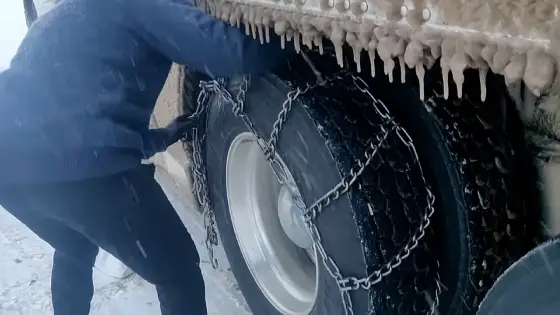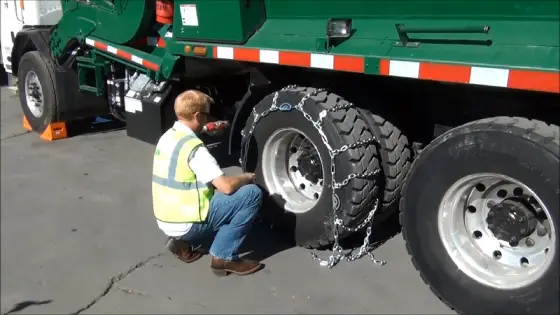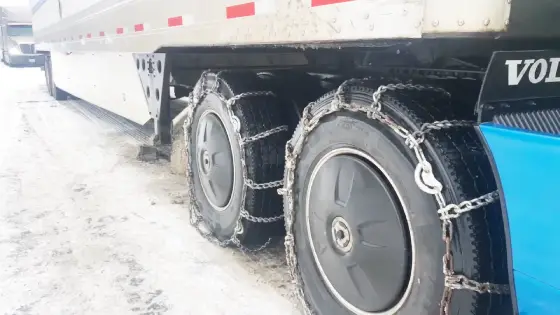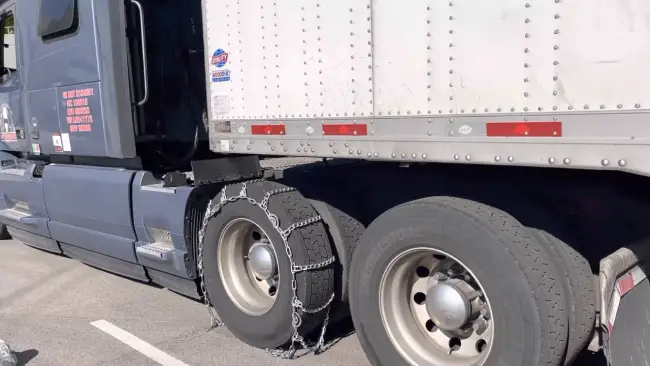Last Updated on July 22, 2023
As winter approaches, you eagerly plan your next adventure, a winter road trip, a ski getaway, or a cozy camping retreat. But, navigating snowy or icy conditions with a trailer in tow can present unique challenges and safety concerns. Now, you may be wondering: do you put chains on trailer tires?
In certain jurisdictions and during severe wintry conditions, using chains on your trailer tires may be not only recommended but also legally required. These simple yet crucial safety devices can significantly enhance traction, maneuverability, and braking, ensuring a safer journey for both you and others on the road.
Winter towing should always be done with safety in mind. Alongside installing snow chains on your trailer tires, driving with caution, reducing your speed, and maintaining ample braking distance from other vehicles is vital.
We’ll get into the details, providing you with all the information you need to safely and confidently navigate those snowy roads with chains on your trailer tires.
When to Use Trailer Tire Chains?

Chains are needed on trailer tires under several conditions. The quick look is as follows:
- Snowy Road Conditions
- Icy Surfaces
- Steep Inclines
- Slippery Terrain
- Heavy Snowfall
- Extreme Weather Conditions
- Low Traction Areas
- Hazardous Driving Conditions
- Off-Road Adventures
Let’s know the condition in-depth.
1. Snowy Road Conditions
Navigating through treacherous snowy road conditions with trailer tires may require the use of chains to ensure optimal traction.
When the road is covered in snow and ice, the tires can easily lose grip, making it difficult to control the trailer.
Attaching chains to the tires increases the surface area in contact with the road, enhancing traction and stability. The chains bite into the snow, providing better grip and preventing the tires from sliding or spinning.
This added traction is especially important when driving uphill or downhill on slippery slopes. Choosing the right chains for your trailer tires is crucial, ensuring a proper fit and secure installation.
Remember to drive at a reduced speed and maintain a safe following distance to enhance your safety on snowy roads further.
2. Icy Surfaces
Be careful on icy surfaces, as they can turn your journey into a treacherous ice rink. When driving on icy roads, it is crucial to take extra precautions to maintain control of your vehicle.
Tire chains are one of the most effective ways to improve traction on icy surfaces. These chains are designed to provide added grip on slippery roads, allowing you to maintain better control and reduce the risk of accidents.
To help you understand the benefits of using tire chains on icy surfaces, let’s take a look at the following table:
| Advantages of Using Tire Chains on Icy Surfaces | Disadvantages of Using Tire Chains on Icy Surfaces |
| Improved traction and control | Increased road noise and vibration |
| Enhanced braking capabilities | Reduced fuel efficiency |
| Increased stability | Potential damage to roads |
| Better maneuverability | Installation and removal can be time-consuming |
By using tire chains, you can significantly improve your safety on icy surfaces. However, it is important to note that tire chains can also have some drawbacks. It’s crucial to weigh the advantages and disadvantages to determine if using tire chains is the right choice for your specific situation.
3. Steep Inclines
Confess those steep inclines with confidence by following these helpful tips. When facing a steep incline with your trailer, taking the necessary precautions to ensure a safe and successful ascent is important.
Here are some tips to keep in mind:
- Engage the proper gear: Before tackling the incline, shift your vehicle into a lower gear to give it more power and control.
- Maintain a steady speed: Avoid accelerating or decelerating abruptly, as this can cause your tires to lose traction. Instead, maintain a consistent speed throughout the climb.
- Use your brakes wisely: While climbing, it’s important to avoid excessive use of your brakes. Instead, let the engine and transmission do the work of controlling your speed.
4. Slippery Terrain
When faced with slippery terrain, it’s important to assess the truth of theories about traction to ensure a safe journey. Contrary to popular belief, there may be better solutions than putting chains on trailer tires.
While chains do provide extra grip on icy or snowy surfaces, they can actually reduce traction on wet or muddy terrain. This is because the chains can dig into the ground and cause the tires to lose contact with the surface, leading to a loss of control.
Instead, consider using specialized tires that are designed for slippery conditions. These tires have deeper treads and are made from a softer rubber compound, which allows them to grip the surface better.
Reducing your speed and maintaining a safe following distance can also help improve traction on slippery terrain. Remember, adapting your driving techniques to the specific conditions you encounter is important to ensure a safe and smooth journey.
5. Heavy Snowfall
If you encounter heavy snowfall, choosing appropriate tires and adjusting your driving techniques are crucial to ensure a safe journey.
For tackling heavy snow, you need tires that are specifically designed for snowy conditions. Look for tires with the ‘snowflake’ symbol, indicating that they meet the industry’s severe snow service requirements.
These tires have deeper tread patterns and special rubber compounds, providing better traction on icy and snowy surfaces.
Additionally, consider using tire chains for added grip and stability. Chains can significantly improve traction and prevent your trailer tires from slipping or sliding on slippery roads.
Remember to install the chains properly and remove them when you reach a clear road to avoid damaging your tires.
6. Extreme Weather Conditions
Prepare yourself for extreme weather conditions by equipping your vehicle with the appropriate tires and adjusting your driving techniques for optimal safety and control.
Imagine driving through a blinding snowstorm in the mountains, where visibility is reduced to just a few feet ahead, and the strong winds make it difficult to stay on the road. In such conditions, having the right tires that can provide traction and stability is crucial.
Chains on trailer tires can be a lifesaver in extreme weather. They enhance grip on icy or snowy surfaces, preventing the trailer from sliding or swaying uncontrollably.
7. Low Traction Areas
Now that we’ve discussed how extreme weather conditions can impact the need for tire chains on trailers let’s delve into another important factor: low traction areas. These areas pose a significant risk for trailers, as they can cause loss of control and accidents. Low traction areas demand extra precautions, whether it’s muddy terrain, loose gravel, or icy roads.
Using chains on your trailer tires is essential to navigate these treacherous conditions. Here are three reasons why:
- Enhanced grip: Chains provide additional traction, allowing your trailer tires to grip the surface better, reducing the chances of sliding or skidding.
- Improved braking: Chains increase the stopping power of your trailer, enabling you to brake more effectively in low traction areas.
- Better stability: With chains on your tires, your trailer will have increased stability, preventing it from swaying or fishtailing.
Remember, when it comes to low traction areas, don’t take any chances – ensure your trailer tires are equipped with chains for maximum safety.
8. Hazardous Driving Conditions
Navigating hazardous driving conditions can be challenging, especially without proper precautions like equipping your trailer with chains for maximum safety.
Having chains on your trailer tires can greatly improve traction and control in these situations.
Chains provide additional grip by biting into the road’s surface or terrain, preventing your tires from slipping or sliding. This increased traction allows you to control your trailer better, making it easier to navigate through low-traction areas.
It’s important to ensure that the chains are properly installed and tightened, as loose chains can cause damage to your trailer and create additional hazards on the road.
9. Off-Road Adventures
Embarking on off-road adventures can take you on a thrilling journey through rugged terrains, putting your driving skills to the test.
Whether you are an experienced off-roader or a beginner, it is crucial to understand the challenges that come with this type of driving.
One essential aspect to consider is the type of tires you have on your trailer. The right tires can significantly affect how well your trailer performs off-road. It is recommended to invest in off-road tires that have deep treads and are designed to provide maximum traction on uneven surfaces.
These tires are specifically built to withstand the demands of off-road driving, offering better grip and control.
What to Consider When Putting Chains on Trailer Tires?

There are several key points to consider when putting chains on your trailer tires. Let’s know them in detail.
1. Trailer Tire Size
To properly fit your trailer, make sure you’ve got the right size tires. The size of your trailer tires plays a crucial role in ensuring safe and efficient towing.
Selecting the correct tire size based on the weight capacity and load rating required for your trailer is important.
It is essential to choose a tire size that can handle the weight of your trailer and its contents. Using tires with the wrong size can lead to poor handling, increased fuel consumption, and potential safety hazards.
2. Weight Distribution Considerations
Make sure your trailer weight is distributed evenly to ensure a smooth and stable towing experience, avoiding any unexpected swaying or fishtailing that could potentially jeopardize your safety on the road. Proper weight distribution is crucial for maintaining control and stability while towing a trailer.
When the weight is not evenly distributed, it can cause the trailer to become unbalanced and prone to swaying from side to side. To achieve optimal weight distribution, start by loading heavy items low and towards the front of the trailer. This will help distribute the weight evenly and keep the trailer balanced.
Additionally, using a weight distribution hitch can help redistribute the weight from the rear axle of your vehicle to the front axle, improving stability and control. Remember, a well-balanced trailer will result in a safer and more enjoyable towing experience.
3. Chain Installation Method
Ensure a secure and reliable towing experience by properly installing your chains using the recommended method. Follow these steps for a hassle-free installation:
- Position the trailer on level ground to ensure stability during the process.
- 2. Lay out the chains in front of the trailer tires and make sure they’re untangled and ready for installation.
- Begin by securing the first end of the chain around the tire closest to the trailer hitch, making sure it’s snug and properly tightened.
- Move to the opposite side and repeat the process, ensuring the chain is evenly distributed across the tire.
- Finally, connect the two ends of the chain together using the provided fastening mechanism, such as a hook or a latch.
4. Chain Compatibility With Trailer
To ensure chain compatibility with your trailer, it’s essential to ensure that the chains you choose are suitable for the size and weight of your trailer.
Trailer chains are specifically designed to provide extra traction and stability, especially in challenging road conditions. They’re available in various sizes and strengths to accommodate different types of trailers.
Before purchasing chains for your trailer, it’s crucial to consider the load capacity, tire size, and the type of terrain you’ll be driving on.
How many tire chains are required for your trailer: four or two?

Four tire chains on your trailer can provide additional traction and stability, especially in challenging mountain conditions. While it’s only legally required to have chains on one axle, opting for four chains (two sets) on your 4 x 4 trailer can offer significant benefits.
With all four tires equipped with chains, you can ensure maximum grip on icy or snowy roads, reducing the risk of skidding or getting stuck.
The additional chains also distribute the weight evenly across all four tires, enhancing stability and control while towing. This can be especially important when maneuvering sharp turns or navigating steep slopes.
By using two sets of chains, you’re taking a proactive approach to ensure the safety and smooth operation of your trailer, providing you with peace of mind during mountain travels.
On which tires of your trailer do you need to place chains?
When placing chains on your trailer tires, it’s important to follow the guidelines based on the type of vehicle you have.
Travel trailers typically have their drive axle at the rear of the trailer. Therefore, it is crucial to place the tire chains on the rear tires of your trailer. This ensures that you have the necessary traction and control while towing your trailer in slippery or icy conditions.
Placing the chains on the rear tires allows the wheels to grip the road properly, preventing any potential sliding or loss of control.
What speed do you put chains on trailer tires?
To ensure the safety of your journey, it’s crucial to carefully consider the appropriate speed at which you should install chains on your trailer’s tires.
Most manufacturers recommend a maximum speed of 30 mph with chains on. This speed limit is in place to prevent any potential damage to your trailer tires or vehicle.
Driving too fast can cause the chains to break, leading to scratches on your car’s exterior paint or even tire damage. It’s important to remember that if road conditions warrant the use of chains, you’ll likely be driving slower anyway.
Dominate Slippery Roads with Tire Chains
So, there you have it. Now you know all about putting chains on trailer tires. Remember, when the roads get icy and treacherous, it’s time to break out those tire chains and give your trailer the extra grip it needs.
Just make sure to consider the weight of your trailer and choose the appropriate number of chains. And don’t forget to place them on the tires that need it the most.
Take it slow and steady, and you’ll be confidently cruising through the winter wonderland. Happy trails.



